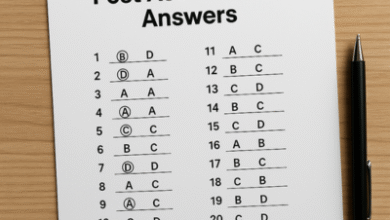SAMS Odisha: Revolutionizing Student Admissions and Academic Management in Odisha

In the evolving landscape of Indian education, digitization plays a pivotal role. Across many states, online portals have transformed how students apply, institutions communicate, and data is managed. In Odisha, SAMS — the Student Academic Management System — stands as a remarkable example of this transformation. It has become the backbone of admissions, academic services, and administration across multiple levels of education in the state.
This article explores how SAMS Odisha works, its history, features, process, and impact, along with tips for students preparing for the 2025 admission cycle.
What Is SAMS Odisha?
SAMS Odisha is an integrated, state-level web portal maintained by the Government of Odisha to handle e-Admission and e-Administration across schools, colleges, and vocational institutions.
- e-Admission: The centralized platform where students apply, choose preferences, check merit lists, and complete admission formalities for courses like +2 (Class XI/XII), +3 (Undergraduate), ITI, Diploma, B.Ed, and more.
- e-Administration: After admission, the system enables institutions and students to manage administrative processes such as registrations, academic records, fee management, and updates online.
Before SAMS, admissions were largely manual — involving physical forms, long queues, and limited transparency. The portal now ensures accessibility, fairness, and efficiency for lakhs of students every year.
Historical Background & Expansion
SAMS started in 2009–10 in only 60 junior colleges. Over the years, it expanded in phases:
- In 2010–11, the system reached 169 junior colleges and 53 degree colleges.
- Later, it was extended to self-financed, private, ITI, diploma, and teacher education institutions.
Today, SAMS covers nearly all academic streams — from junior (+2) and degree (+3) levels to vocational, technical, and teacher training courses. It also functions as a digital academic record system, storing data throughout a student’s educational journey.
Key Features & Advantages
SAMS Odisha brings many benefits to students, institutions, and policymakers.
1. Common Application Form (CAF)
Students can apply to multiple institutions through one online form instead of visiting each campus separately. This saves time, money, and effort.
2. Transparent, Merit-Based Admission
Seats are allotted based on marks and student preferences, reducing bias and ensuring fair competition.
3. Remote Accessibility
The entire process — from application to seat confirmation — can be completed online from anywhere.
4. Notifications & Real-Time Updates
Applicants get SMS and email alerts about registration, merit lists, and reporting deadlines.
5. Multi-Level Course Coverage
SAMS caters to multiple education levels — +2, +3, ITI, Diploma, B.Ed, PG, and more — under one umbrella.
6. Centralized Data for Governance
For the government, SAMS acts as a single database that helps monitor enrollment rates, track dropout trends, and plan new education policies.
7. Mental Health Support
Recently, SAMS integrated mental health assistance through Tele-MANAS helplines, helping students cope with stress during admissions.
The Step-by-Step Admission Process (2025 Example)
Here’s a detailed walkthrough of how the SAMS Odisha admission process works.
1. Official Notification
The Department of Higher Education (DHE) releases notifications outlining key dates, eligibility, and documents. These notices appear on the official SAMS portal and in newspapers.
2. Registration
Eligible students first register with their basic details — name, date of birth, contact number, and previous exam results. After verification via OTP or email, a unique ID is generated.
3. Filling the Common Application Form (CAF)
Students log in, fill the CAF, and list their preferred colleges and courses. They must upload documents such as photos, mark sheets, and certificates in the correct format.
4. Payment of Application Fee
A small fee (depending on category) is paid online through debit card, UPI, or net banking.
5. Merit List & Allotment
After evaluation, SAMS publishes the merit list and seat allotment results. Students can view their selection status using their login credentials.
6. Reporting & Document Verification
Selected students must report to the allotted college within the given timeline to verify their documents and confirm admission.
7. Slide, Float, or Freeze Options (for +3 Admissions)
Students can:
- Slide: Move to a higher preferred choice if available.
- Float: Keep current seat while waiting for a better option.
- Freeze: Finalize the allotted seat.
8. Spot Admission Rounds
If seats remain vacant after regular rounds, additional or spot admission rounds are held. Students who missed earlier opportunities can still participate.
9. Start of Academic Session
Once verification is complete, institutions start classes for the new academic year — generally by late July for +2 and August for +3 admissions.
Admission & Eligibility Guidelines
- Eligibility: For +2 admission, passing Class 10 is required; for +3, passing +2 or its equivalent is mandatory.
- Streams: Arts, Science, Commerce, Vocational, Sanskrit, and technical courses are offered.
- Reservation: Seats are reserved for SC, ST, SEBC, PWD, and other categories as per state policy.
- Fee Exemption: Certain categories, such as SC/ST or economically weaker students, may receive concessions.
- Documents Required: Mark sheets, certificates, ID proof, caste certificate (if applicable), passport-sized photo, and signature.
2025 Admission Highlights
- Extended Deadlines:
The +3 registration deadline was extended to June 1, 2025, allowing students more time to complete applications. - Second Merit List:
Released on June 22, 2025, giving many applicants a second chance for admission. - +2 Admission Timeline (2025–26):
- Application Start: May 24
- Last Date: June 30
- 1st Merit List: July 7
- Reporting: July 8–14
- 2nd Merit List: July 21
- Spot Admission: July 30
- Classes Begin: July 24
- Cut-Off Trends:
The first cut-off for Class XI admissions showed over 92% of applicants being allotted seats in the first round, covering nearly 2,400 schools statewide. - Focus on Mental Health:
SAMS now displays counseling helpline details during admission steps to support students emotionally.
Challenges and Areas of Improvement
Even with its success, SAMS Odisha faces certain issues that can be refined over time.
1. Server Downtime
During peak traffic — especially near deadlines — the system can slow down or crash temporarily.
2. Internet Accessibility
Students in remote villages often struggle with connectivity or lack digital literacy, creating inequality in access.
3. Document Upload Issues
Incorrect formats or unclear scans lead to rejections and delays.
4. Communication Gaps
Students sometimes miss critical notifications due to email delivery failures or spam filtering.
5. Schedule Changes
Occasional extensions or sudden updates can create confusion if students don’t check the portal regularly.
6. Need for Stronger Data Privacy
As SAMS stores vast student data, ensuring proper security and privacy measures is vital.
Tips and Best Practices for Students
- Apply Early: Avoid last-minute rushes to prevent server delays.
- Use Correct Details: Double-check your name, date of birth, and marks.
- Prepare Documents in Advance: Keep scanned copies in the right size and format.
- Plan Choices Wisely: Combine ambitious and safe college options to improve your chances.
- Check Notifications Frequently: Visit the portal every day during the admission period.
- Verify Allotment Properly: Once a seat is allotted, confirm within the deadline to avoid cancellation.
- Seek Help When Needed: Use the toll-free helpline or local SAMS resource centers for guidance.
- Stay Calm: Admissions can be stressful — use mental health support if needed.
The Broader Impact of SAMS Odisha
SAMS Odisha has reshaped education access in the state by:
- Promoting Equity: Students from all backgrounds compete on the same merit-based platform.
- Reducing Corruption: Transparent selection reduces unfair practices.
- Saving Time and Costs: Both institutions and applicants save paperwork and travel expenses.
- Empowering Students Digitally: Encouraging young learners to adapt to online systems.
- Improving Governance: Data-driven decisions help authorities allocate seats, plan infrastructure, and identify trends.
The Future of SAMS Odisha
As technology evolves, SAMS Odisha is expected to grow in new directions:
- Mobile Application: A dedicated mobile app for faster, offline-friendly access.
- AI Chatbot Support: Instant help for form-filling and FAQs.
- Integrated Scholarship System: Linking scholarships and fee waivers directly through SAMS.
- Predictive Analytics: Using data to forecast seat demand and design new courses.
- Enhanced Data Protection: Strengthening security to ensure confidentiality of student data.
Real-Life Scenarios
Riya’s Journey
Riya, from a rural village in Odisha, applies for +2 Science using SAMS. She fills the online form from her school’s computer, gets her merit list result on her phone, and travels once to her allotted college for verification — saving days of travel and expense.
Arjun’s Experience
Arjun applies for +3 Arts, lists several colleges, and gets his second-choice college initially. Later, he uses the slide option to move up to his top preference when a seat becomes available — showcasing SAMS’s flexibility.
Conclusion
SAMS Odisha is one of the most successful examples of digital education management in India. It has revolutionized how admissions are conducted — from paperwork-heavy, time-consuming, and often biased systems to a fair, transparent, and efficient process.
With continuous improvements, better outreach, and integration of technology, SAMS will continue empowering millions of students in Odisha. It is not merely a software platform — it’s a bridge to a more equitable and efficient education ecosystem.
This detailed article is published on my blog Newsta, dedicated to informative updates and educational insights for students and young readers.Thanks for read our article if you want more like this kind of article visit our site Newsta, and comment us. We provide authentic & comprehensive information to our readers.
1. What is SAMS Odisha?
SAMS Odisha (Student Academic Management System) is an online platform developed by the Government of Odisha to manage e-Admission and e-Administration for schools, colleges, and vocational institutions. It helps students apply for +2, +3, ITI, Diploma, B.Ed., and other courses from a single portal.
2. How can I apply for admission through SAMS Odisha?
Students must register on the official SAMS Odisha portal, fill out the Common Application Form (CAF), select preferred colleges and courses, upload required documents, and submit the form online. Admissions are then conducted based on merit lists released by the system.
3. Which courses are available on the SAMS Odisha portal?
SAMS Odisha supports admissions for multiple streams and education levels including Higher Secondary (+2), Degree (+3), Industrial Training Institutes (ITI), Diploma, Teacher Education (B.Ed), Physical Education, and Postgraduate programs.
4. What is the Common Application Form (CAF) in SAMS Odisha?
The CAF is a single online form that allows students to apply to multiple colleges and courses under the SAMS system without submitting separate forms for each institution.
5. How are seats allotted in SAMS Odisha?
Seats are allotted purely on merit, based on the marks obtained in previous qualifying examinations and the student’s chosen preferences. The allotment is published online, and students can check their results using their login credentials.
6. What documents are required for SAMS Odisha admission?
Students generally need to upload scanned copies of their mark sheets, certificates, category or caste certificate (if applicable), a recent photograph, and their signature. Original documents are verified later at the allotted institution.
7. What are “Slide,” “Float,” and “Freeze” options in SAMS Odisha?
- Slide: Apply for a better preferred college or course while keeping the current one as backup.
- Float: Continue with the current seat but remain open for upgrades.
- Freeze: Accept the current seat and stop participating in further rounds.
8. How can I check the merit list in SAMS Odisha?
Students can log in to the SAMS portal and view their selection status or download the merit list for their respective courses from the “Merit List” section.
9. What should I do if I miss the admission deadline?
If you miss the initial rounds, you can participate in the Spot Admission round, which is held to fill remaining vacancies after regular rounds.
10. Is there any helpline for SAMS Odisha queries?
Yes. Students can contact the official SAMS Odisha helpline at 155335 or 1800-345-6770 for assistance related to registration, login, or admission issues.
11. Does SAMS Odisha provide scholarships?
While SAMS primarily handles admissions, some integrated systems allow students to access scholarship portals linked with their academic data. Students are advised to check for scholarship announcements during or after admission.
12. How is SAMS Odisha helping rural students?
SAMS has made admissions more accessible by digitizing the entire process. Rural students can apply online through nearby resource centers or schools without needing to travel long distances to multiple institutions.
13. When do SAMS Odisha classes usually start?
Typically, +2 classes begin in late July and +3 degree classes start in August after completion of admission rounds and document verification.
14. Is the SAMS Odisha website open all year round?
Yes, the website remains active year-round, but the application and admission modules are opened according to the official academic calendar for each course.
15. Can I edit my SAMS Odisha form after submission?
Minor corrections are allowed only during officially announced “Edit Windows.” Students must check notifications regularly to avoid missing this opportunity.



